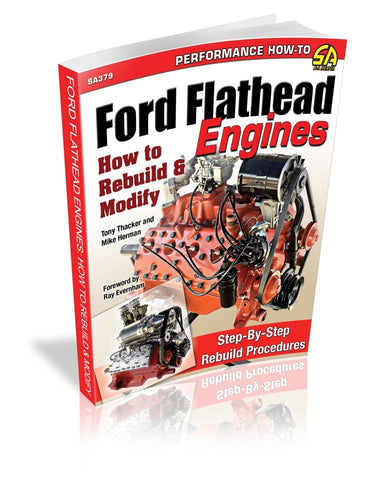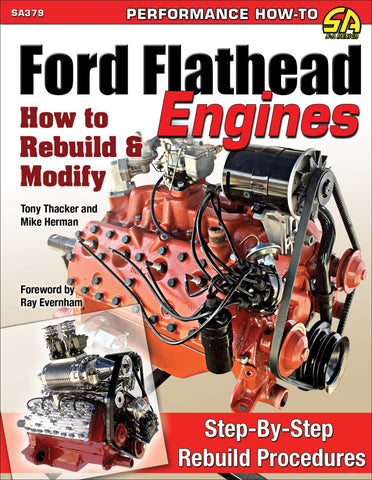Get your hot rod back on the road by rebuilding its Ford Flathead engine using this comprehensive guide that features expert advice and detailed step-by-step sequences.
In Ford Flathead Engines: How to Rebuild & Modify, veteran author Tony Thacker and flathead guru of H&H Flatheads, Mike Herman, take you through rebuilding a flathead. One of the most important steps is to actually find a good, usable core; many have been sitting for a very long time and the engine design is prone to cracking. Running changes are also an important consideration when selecting a core and include the cooling system, ignition, and transmission mount.
After you have selected a core, Thacker and Herman take you through the entire process of a rebuild, including teardown, parts inspection, machine shop processes, replacement part selection, reassembly, start up, and break-in.
Although not the first V-8 engine ever produced, Henry Ford's side-valve V-8, launched in 1932, certainly qualified as the first mass-produced V-8 sold to the public. Because of Henry Ford's stubbornness, the first versions were less than ideal. The technology was in its infancy, and cost-cutting measures limited the output and reliability of the early models. Over time, however, the “Flattie” became the go-to powerplant for a whole generation of new hobbyists who were called “hot rodders.” The engine maintained its position in the hobby well into the 1950s, even when more modern overhead-valve designs started coming out of Detroit. It's hard to overstate the impact that this simple little engine had on a whole generation of enthusiasts. Even today, people choose a flathead for period-correct builds over far more powerful options. The style and sound of a modified flathead is an iconic part of American history.
Also covered is a unique performance build completed at the H&H shop for legendary race car team manager and all-around enthusiast Ray Evernham. It all adds up to a must-have book with more than 500 color photos and insider tips on building what could be called the most iconic engine ever built: the Ford flathead V-8.
Dedication
Foreword by Ray Evernham
About the Authors
Introduction
Chapter 1: A Brief History of the Ford Flathead V-8
Growing Pains
Surviving the Great Depression
Building Up to the End
Chapter 2: Engine ID, Equipment and Tools
What Is the Goal?
Selecting a Candidate
Identification Research
Cleanup
Special Tools
Basic Tools
Chapter 3: Disassembly
Fuel Pump, Starter and Accessories
Intake Manifold, Water Pump and Timing Cover
Cylinder Heads
Oil Filter, Pan and Pump
Bearing Caps
Rods and Pistons
Valve Assembly
Bellhousing and Clutch Assembly
Chapter 4: Cleaning
Block Cleaning
Hot Tanking
Rust Removal
Cylinder Head Cleaning
Crankshaft Cleaning
Sludge Trap Plugs Removal
Chapter 5: Inspection
Crack Detection
Magnafluxing
Pressure Testing
Head Inspection
Crank Inspection
Rod Inspection
Sonic Testing
Chapter 6: Machine Shop
Blueprinting and Balancing
Balancing and Honing the Rods
Balancing the Pistons
Balancing the Crank
Crack Repair
Cylinder Boring
Align Boring
Sleeving
Honing
Decking
Power Slot Relieving
Pressure Sealing
Valveseat Installation
Valveseat Grinding
Cylinder Heads
Chapter 7: Selecting Parts
Source List
Chapter 8: Final Assembly
Oil Gallery Plug
Camshaft
Oil Pump Gear
Fuel Pump Pushrod Bushing
Valvetrain
Oil Deflectors
Crankcase Breather Tube
Rear Oil Slinger
Crankshaft
Pistons
Camshaft Gears
Oil Pump
Crankshaft
Water Pump
Oil Pan
Pulleys
Flywheel
Head and Head Gasket
Finishing
Chapter 9: Start-Up
Run-In Procedure
Fire-Up in the Car
Chapter 10: Building a Performance Flathead
Block
Rotating Assembly
Porting the Block
Porting the Intake Manifold
Valves
Block Honing
Assembly
Oil Pan
Heads
Appendix
Cylinder Numbers and Firing Orders
Torque Sequence
Serial Numbers
Source Guide
Get your hot rod back on the road by rebuilding its Ford Flathead engine using this comprehensive guide that features expert advice and detailed step-by-step sequences.
In Ford Flathead Engines: How to Rebuild & Modify, veteran author Tony Thacker and flathead guru of H&H Flatheads, Mike Herman, take you through rebuilding a flathead. One of the most important steps is to actually find a good, usable core; many have been sitting for a very long time and the engine design is prone to cracking. Running changes are also an important consideration when selecting a core and include the cooling system, ignition, and transmission mount.
After you have selected a core, Thacker and Herman take you through the entire process of a rebuild, including teardown, parts inspection, machine shop processes, replacement part selection, reassembly, start up, and break-in.
Although not the first V-8 engine ever produced, Henry Ford's side-valve V-8, launched in 1932, certainly qualified as the first mass-produced V-8 sold to the public. Because of Henry Ford's stubbornness, the first versions were less than ideal. The technology was in its infancy, and cost-cutting measures limited the output and reliability of the early models. Over time, however, the “Flattie” became the go-to powerplant for a whole generation of new hobbyists who were called “hot rodders.” The engine maintained its position in the hobby well into the 1950s, even when more modern overhead-valve designs started coming out of Detroit. It's hard to overstate the impact that this simple little engine had on a whole generation of enthusiasts. Even today, people choose a flathead for period-correct builds over far more powerful options. The style and sound of a modified flathead is an iconic part of American history.
Also covered is a unique performance build completed at the H&H shop for legendary race car team manager and all-around enthusiast Ray Evernham. It all adds up to a must-have book with more than 500 color photos and insider tips on building what could be called the most iconic engine ever built: the Ford flathead V-8.
Dedication
Foreword by Ray Evernham
About the Authors
Introduction
Chapter 1: A Brief History of the Ford Flathead V-8
Growing Pains
Surviving the Great Depression
Building Up to the End
Chapter 2: Engine ID, Equipment and Tools
What Is the Goal?
Selecting a Candidate
Identification Research
Cleanup
Special Tools
Basic Tools
Chapter 3: Disassembly
Fuel Pump, Starter and Accessories
Intake Manifold, Water Pump and Timing Cover
Cylinder Heads
Oil Filter, Pan and Pump
Bearing Caps
Rods and Pistons
Valve Assembly
Bellhousing and Clutch Assembly
Chapter 4: Cleaning
Block Cleaning
Hot Tanking
Rust Removal
Cylinder Head Cleaning
Crankshaft Cleaning
Sludge Trap Plugs Removal
Chapter 5: Inspection
Crack Detection
Magnafluxing
Pressure Testing
Head Inspection
Crank Inspection
Rod Inspection
Sonic Testing
Chapter 6: Machine Shop
Blueprinting and Balancing
Balancing and Honing the Rods
Balancing the Pistons
Balancing the Crank
Crack Repair
Cylinder Boring
Align Boring
Sleeving
Honing
Decking
Power Slot Relieving
Pressure Sealing
Valveseat Installation
Valveseat Grinding
Cylinder Heads
Chapter 7: Selecting Parts
Source List
Chapter 8: Final Assembly
Oil Gallery Plug
Camshaft
Oil Pump Gear
Fuel Pump Pushrod Bushing
Valvetrain
Oil Deflectors
Crankcase Breather Tube
Rear Oil Slinger
Crankshaft
Pistons
Camshaft Gears
Oil Pump
Crankshaft
Water Pump
Oil Pan
Pulleys
Flywheel
Head and Head Gasket
Finishing
Chapter 9: Start-Up
Run-In Procedure
Fire-Up in the Car
Chapter 10: Building a Performance Flathead
Block
Rotating Assembly
Porting the Block
Porting the Intake Manifold
Valves
Block Honing
Assembly
Oil Pan
Heads
Appendix
Cylinder Numbers and Firing Orders
Torque Sequence
Serial Numbers
Source Guide










